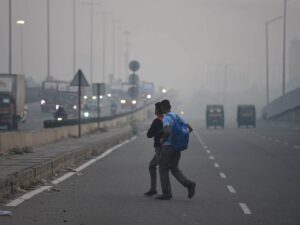A global study that was recently published in npj Clean Air reveals a disturbing trend – air pollution from fires is rising globally, actively reversing many years of progress in clean air. The study analyzed population exposure to fine particulate matter (PM2.5) from land fires, namely wildfires, and controlled burns, and evaluated related health impacts.
Risks to Human Health and Fire
Wildfires happen in many different areas, including forests, rangelands, and agricultural areas. While fires can happen from non-human sources, it is well established that the majority of wildfires (and soon to be all wildfires) in a hotter climate are caused by humans. Climate change is amplifying temperatures, dryness, and durations of fires. Consequently, fires are sources in the air of pollutants such as PM2.5, volatile organic compounds (vocs) and toxic gases. Acute exposure to smoke can have drastic effects on human health causing respiratory disease, cardiovascular disease, mental illness, and others.
Core Findings
Researchers from the CICERO Center for International Climate Research (Norway) and the Finnish Meteorological Institute used the SILAM chemical transport model to analyze trends in wildfire-related PM2.5 exposure from 1990 – 2018.
• Worldwide Trends: Although there was an overall reduction in PM2.5 exposure in wealthy regions, such as North America and Europe, there was a substantive increase in PM2.5 exposure from direct fire in wealthy regions, especially in boreal summers. Developing areas, especially South Asia and sub-Saharan Africa saw continued increased exposure from both fire and overall PM2.5 exposure.
• Regional Hotspots: Tropical Latin America, especially Brazil and Bolivia saw increased extreme fire-smoke days. Central sub-Saharan Africa experienced chronic fire exposure, and did not experience reductions in fire exposure like other regions.
• Population Impact: By 2018, more than half of the world’s population (53%) reported some level of chronic exposure from fire, and approximately 228 million people (3.2%) reported substantial continuing exposure to fire, mostly in sub-Saharan Africa and Latin America. Among the countries from which new all-day, extreme exposure was reported, the countries with the highest per 1,000 population increases included Mali, Brazil, the Democratic Republic of the Congo, Bolivia, Russia and Georgia.
Health Burden
Researchers analyzed mortality risk associated with acute fire particle pollution exposure in several countries using health datasets. Some key findings include:
• The annual number of deaths globally from all-cause fire PM2.5 exposure increased from around 69,000 between 1990-1999 to around 99,000 deaths between 2010-2018.
• Deaths from respiratory illness increased from around 7,000 to 9,000 per year while deaths from cardiovascular disease increased from around 17,000 to around 30,000.
• Eastern Europe and sub-Saharan Africa had the highest burden of mortality; North Africa and the Middle East had a high burden of deaths from cardiovascular disease with moderate levels of PM2.5 exposure – indicating a dynamic vulnerability within regions to mitigate the impacts of exposure.
• The major proportion of respiratory deaths occurred in children under five years of age, whereas deaths from cardiovascular disease were most often experienced by patients over 60 years of age.
While increasing exposures were noted, it is also important to note that the crude death rate for all-cause deaths globally decreased slightly- suggesting possible improvement in health status at baseline.
The results of the study indicate that while average air quality improved in some regions, there has been PM2.5 increase associated with fire activity in all vegetated continents. This presents risks to public health due to continued major fire events and duration of exposures, negating positive effects of clean air legislation. Researchers argue for sustainable forest management and fire prevention plans, particularly for emissions that are more toxic than those from other sources.












More Stories
Centre Steps Up Health Response: States, UTs Asked to Strengthen Clinics for Air Pollution-Related Diseases
Neurologist Warns: These 3 Everyday Habits Could Be Silently Damaging Your Brain
Fitness Trainer Reveals the Body’s Most Underrated Weapon Against Diabetes—‘Muscle Can Soak Up Glucose Even Without Insulin’